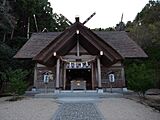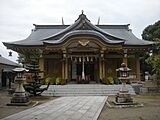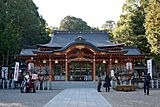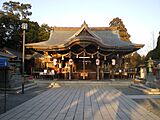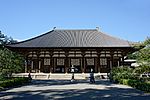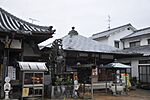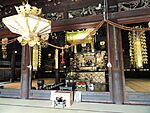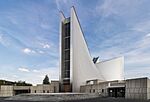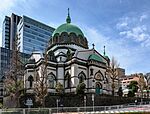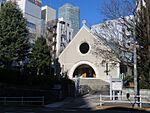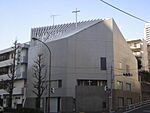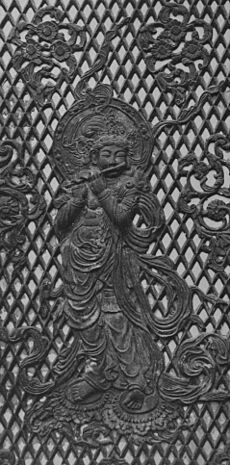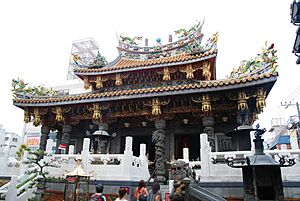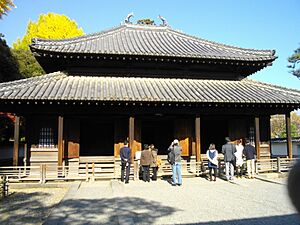Religion in Japan facts for kids
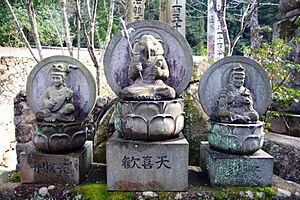
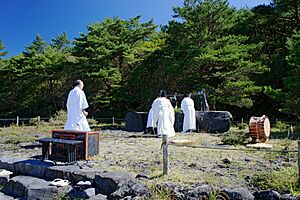
Religion in Japan is mainly about two big faiths: Shinto and Buddhism. Many Japanese people follow both at the same time. It's common for these two religions to mix, a practice known as shinbutsu-shūgō. This mix was Japan's main way of practicing religion before the 1800s.
The way Japanese people think about religion is a bit different from some other cultures. They often focus on rituals and practices that bring good fortune and well-being. The specific beliefs or rules are sometimes less important. Many Japanese people don't officially say they belong to a religion, even if they visit shrines and temples. For example, only a small number identify as "Shinto" in surveys, because that term often means joining a specific Shinto group. Some might say they have "no religion" ("without religion" (無宗教, mushūkyō)), but this doesn't mean they don't believe in anything. It often means they follow common religious customs without joining a formal organization.
Contents
Main Religions in Japan
Shinto: Japan's Ancient Way
Shinto (神道, Shintō), which means "way of the divine" or "way of the gods," is Japan's native religion. It focuses on special rituals that connect modern Japan with its ancient past. The oldest written records, like the Kojiki and Nihon Shoki from the 700s, describe early Shinto practices and Japanese mythology.
Today, Shinto involves public shrines where people worship many gods called kami. These shrines are used for various purposes, like celebrating harvests or remembering important events. Shinto followers express their beliefs through similar rituals and clothing styles that have been around since the Nara period (710–794) and Heian period (794–1185).
The word Shinto comes from Chinese words meaning "way of the gods." The oldest use of this word in Japan dates back to the 500s. Kami are like spirits or essences. They refer to the special energy found in nature, like rocks, trees, rivers, animals, and even people. In Shinto, kami and people are not separate; they are part of the same world.
Shinto is the largest religion in Japan, with almost 80% of people participating in its practices. However, as mentioned, only a small number call themselves "Shintoists" in surveys. This is because many Japanese people visit Shinto shrines and pray to kami without joining a formal Shinto group. There are about 100,000 Shinto shrines and nearly 79,000 priests in Japan.
New Shinto Groups
After World War II, Japan changed a lot with new industries and cities. Traditional religions also changed. The 1947 constitution brought religious freedom, which allowed many new religious groups to form.
These new groups, some from Shinto and some from Buddhism, offered a sense of community for people who had moved away from their traditional families and villages. Unlike traditional Shinto, which is often tied to family and local areas, new religions require people to choose to join. They offer shared beliefs and practices for their members across the country.
There are hundreds of officially recognized new religions in Japan, with millions of members. The largest is Soka Gakkai, a Buddhist group started in 1930, with about 4 million members. Many of these new religions come from Shinto and keep its main ideas. Examples include Tenrikyo, Konkokyo, and Omotokyo. Other new religions, like Aum Shinrikyo and Sukyo Mahikari, are independent.
Buddhism: From Korea to Japan
Buddhism (仏教, Bukkyō) first came to Japan in the 500s from the kingdom of Baekje in Korea. The Korean king sent the Japanese emperor a picture of the Buddha and some Buddhist texts. After some initial disagreement, the Japanese court accepted Buddhism in 587. During this time, Japan was influenced by China, which was a powerful country.
Buddhism helped strengthen the Japanese government and its place in East Asian culture. Japanese nobles built many Buddhist temples in the capital city of Nara. However, the government's large spending on Buddhism led to some problems. This caused a shift, and the capital moved to Heian (now Kyoto).
The first six Buddhist groups in Nara are now known as "Nara Buddhism" and are quite small. When the capital moved to Heian, new forms of Buddhism arrived from China. These included Shingon Buddhism, which is a mystical form, and Tendai, a more traditional monastic form.
Later, when the government moved to Kamakura in the 1100s, more Buddhist ideas came to Japan. One of the most important was Zen, which focuses on meditation to achieve enlightenment.
In 1868, during the Meiji Restoration, the government made Shinto the official state religion. They also tried to separate Shinto and Buddhism and reduce the influence of Buddhism in Japan.
Today, Pure Land Buddhism is very popular. It teaches that by repeating the phrase "Namu Amida Butsu", followers can be reborn in the "Pure Land" (a kind of paradise) after death. This teaching appealed to people from all walks of life, from farmers to powerful samurai families. There are two main branches: Jōdo-shū, which emphasizes repeating the phrase many times, and Jōdo Shinshū, which believes saying it once with a pure heart is enough.
Another important form is Nichiren Buddhism, started by the monk Nichiren in the 1200s. It focuses on the Lotus Sutra. Groups like Nichiren Shū and Soka Gakkai (whose political group, Komeito, is a major political party in Japan) follow Nichiren Buddhism. They often chant Namu Myōhō Renge Kyō.
As of 2018, there were over 355,000 Buddhist monks, priests, and leaders in Japan.
Abrahamic Religions in Japan
Christianity: A Journey to Japan
In 2019, there were about 1.9 million Christians in Japan. Many live in western Japan, where missionaries were most active in the 1500s.
Christianity (キリスト教 Kirisutokyō), specifically Catholicism (カトリック教 Katorikkukyō), first came to Japan in 1549 with Jesuit missionaries like Francis Xavier. They landed in Kagoshima, in Kyushu. Local leaders welcomed Portuguese traders who arrived earlier because they brought gunpowder. A Japanese convert named Anjirō helped the Jesuits understand Japanese culture.
Many people in Kyushu, including farmers and warriors, became Christians. By 1569, there were 30,000 Christians and 40 churches. The number grew quickly to 100,000 in the 1570s.
However, near the end of the 1500s, the ruler Toyotomi Hideyoshi banned Christianity. In 1597, he severely punished 26 Franciscans in Nagasaki as a warning. Later, Tokugawa Ieyasu and his successors continued to ban Christianity, especially after the Shimabara Rebellion in the 1630s. Many Christians, known as Kakure Kirishitan, continued to practice their faith in secret.
During the Tokugawa period, the government used its power to declare Christians as enemies. This helped the state control its people. Even though Christianity is often seen as a "foreign" religion, it has played a significant role in Japanese society for centuries.
In 1873, after the Meiji Restoration, the ban on Christianity was lifted, and freedom of religion was allowed. Protestant missionaries (プロテスタント Purotesutanto) then came to Japan, especially after World War II.
Today, some Western customs linked to Christianity, like Western-style weddings, Valentine's Day, and Christmas, are popular in Japan. In 2015, about 60-70% of weddings in Japan were Christian-style. Christianity and Christian culture are generally seen in a positive light in Japan.
Islam in Japan
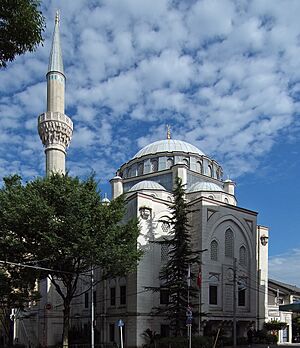
Islam (イスラム教 Isuramukyō) in Japan is mainly practiced by small groups of immigrants from other parts of Asia, like Indonesia, Pakistan, Bangladesh, and Iran. In 2007, there were an estimated 10,000 to 50,000 Muslim immigrants, and a few thousand to tens of thousands of Japanese Muslims.
Bahá'í Faith in Japan
The Bahá'í Faith (バハーイー教 Bahāiikyō) began in Japan with the first Japanese convert in 1902. The first person to become a Bahá'í in Japan itself was in 1915. In 2005, there were an estimated 15,700 Bahá'ís in Japan.
Judaism in Japan
Judaism (ユダヤ教 Yudayakyō) is practiced by about 2,000 Jews living in Japan. When Japan opened up to the world in 1853, some Jews moved there, with the first recorded settlers arriving in Yokohama in 1861. Jewish communities grew in Tokyo and Kobe.
During World War II, some European Jews escaping danger found safety in Japan. A Japanese diplomat named Chiune Sugihara helped over 6,000 Jews get transit visas, allowing them to escape. After the war, many Jews left Japan, with some moving to what is now Israel.
Today, there are Jewish community centers in Tokyo and Kobe. In 2015, Japan appointed its first Chief Rabbi.
Dharmic Religions in Japan
Hinduism in Japan
Hinduism (ヒンドゥー教 Hindūkyō) is followed by a small number of people in Japan, mostly migrants from countries like India and Nepal. However, Hindu culture has had a big, indirect influence on Japanese culture through Buddhism. For example, four of Japan's "Seven Gods of Fortune" originally came from Hindu deities, such as Benzaiten (Sarasvati) and Bishamon (Vaiśravaṇa). Many Hindu gods are also worshipped in Shingon Buddhism.
In 2020, there were about 25,597 Hindus in Japan.
Sikhism in Japan
Sikhism (シク教 Sikukyō) is a small religion in Japan, mainly followed by families who moved from India. Sikh communities started in the 1920s in Kobe and later in Tokyo. They have built places of worship called gurdwaras.
Jainism in Japan
Jainism (ジャイナ教 Jainakyō) is also a minority religion in Japan. As of 2009, there were three Jain temples in the country.
Traditional Religions of East Asia in Japan
Ryukyuan Religion
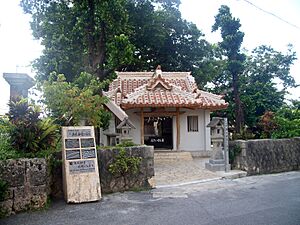
The Ryukyuan religion is the native belief system of the people of Okinawa and the other Ryukyu Islands. It focuses on respecting ancestors and the connections between living people, the dead, and the spirits of nature. This religion has ancient roots in animism, believing that spirits live in everything.
A special part of this religion is the belief in onarigami (おなり神), which means women have a special spiritual role. This led to a class of noro (priestesses) and yuta (female spiritual guides). The Ryukyuan religion has also been influenced by Japanese Shinto, Buddhism, and Chinese religions.
Ainu Folk Religion
The Ainu religion Ainu no shūkyō (アイヌの宗教) is the native belief system of the Ainu people who live in Hokkaido and parts of Russia. It is an animistic religion that believes Kamuy (spirits or gods) live in everything.
Chinese Folk Religion
Most Chinese people in Japan practice Chinese folk religion, also known as Shenism. This religion is similar to Japanese Shinto. It involves worshipping Chinese gods and ancestors, called shen. These shen can be nature gods, city gods, or heroes from history.
Taoism in Japan
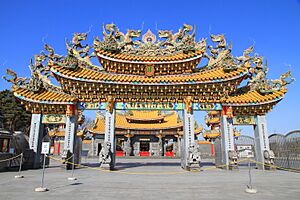
Taoism (道教 Dōkyō) came from China between the 600s and 700s. It influenced Japanese native spirituality, including Shinto. Taoist practices were absorbed into Shinto, and it was a source for mystical religions like Onmyōdō. Today, there are some Taoist temples in Japan, like the Seitenkyū which was founded in 1995.
Confucianism in Japan
Confucianism (儒教 Jukyō) arrived from Korea and became an important philosophy, especially during the Edo period. It teaches that the world can be understood through human reason and that people should create harmony between themselves and the universe. Confucianism also emphasized respect for family and a clear social order.
Samurai were very interested in Confucian ideas and set up many schools to teach them. This philosophy also led to a sense of national pride in Japan.
Religious Practices and Holidays
Many Japanese people take part in rituals and customs from different religious traditions. Important life events often involve visits to both Shinto shrines and Buddhist temples. For example, babies are often taken to a shrine or temple around one month old. Special birthdays for children (ages three, five, and seven, called Shichi-Go-San) and the start of adulthood at age twenty (Seijin shiki) are also celebrated.
Most Japanese weddings today are Christian-style, even if the couple isn't Christian. Shinto weddings and non-religious Western-style weddings are also popular, but less common.
Japanese funerals are usually led by Buddhist priests, and Buddhist rituals are common for remembering family members who have passed away. About 91% of Japanese funerals follow Buddhist traditions.
Japan has two main types of holidays: matsuri (temple fairs) and nenjyū gyōji (annual feasts). Matsuri are mostly Shinto festivals related to rice farming and the well-being of local communities. Nenjyū gyōji often have Chinese or Buddhist origins. Most matsuri are local events, often sponsored by Shinto shrines.
Two of the most important holidays for many Japanese are New Year's Day and Obon. Both involve visiting Shinto shrines or Buddhist temples. New Year's (January 1–3) includes many customs like praying for blessings, wearing a kimono, and eating special foods. During Obon, people set up altars for spirits and clean ancestral graves, expecting the spirits of their ancestors to return. Many people travel to visit relatives, and celebrations include folk dancing and prayers at temples.
Religion and Law in Japan
In early Japanese history, leaders were responsible for religious rituals. Later, governments used religious organizations for political reasons. For example, the Tokugawa shogunate required every family to register with a Buddhist temple. In the 1800s, the government required families to belong to a shrine instead.
The Meiji Constitution in the late 1800s stated that Japanese people had freedom of religious belief, as long as it didn't disturb peace or conflict with their duties.
The 1947 Constitution clearly states: "Freedom of religion is guaranteed to all." It also says that no religious organization should get special treatment from the government or have political power. No one can be forced to take part in any religious act. The government must not teach religion or do any other religious activities. This change helped ensure that schools couldn't promote Shinto beliefs and that people weren't forced to participate in Shinto rituals. This separation of religion and state is an important part of modern Japanese law.
Views on Organized Religion
Some important Japanese thinkers have shared their thoughts on religion.
- Shin'ichi Hisamatsu, a philosopher, believed that ideas of God or Buddha as separate beings were just illusions.
- Ito Hirobumi, who was Prime Minister of Japan four times, reportedly said that religion wasn't really needed for a country. He thought science was better than superstition, and he saw religions like Buddhism or Christianity as superstitions that could weaken a nation.
- Haruki Murakami, a famous Japanese novelist, wrote that "God only exists in people’s minds." He noted that in Japan, the idea of God has always been flexible. He pointed out how the emperor, once seen as divine, declared himself an ordinary person after World War II.
- Fukuzawa Yukichi, a founder of modern Japan, believed it was hard to combine modern learning with belief in gods. He openly said he didn't have a religious nature and didn't believe in any religion, though he thought religion could be useful for keeping peace in society.
There have also been groups that opposed organized religion. For example, the Japan Militant Atheists Alliance was founded in 1931. They were against the idea of a national founding myth, religion in public education, and the practice of State Shinto. They also opposed the imperial system. Another group, the Japan Anti-religion Alliance, formed in the same year. They were against religious organizations receiving money or preaching in factories, seeing religion as a way for powerful people to control others.
Religious Demographics
According to a 2015 government survey, about 70.4% of the population follows Shintoism, and 69.8% follows Buddhism. About 1.5% are Christians, and 6.9% follow other religions. These numbers can add up to more than 100% because many Japanese people follow more than one religion.
Other surveys show that less than 40% of Japanese people identify with an organized religion. For example, surveys from 2006 and 2008 found that around 35% were Buddhists, 3% to 4% belonged to Shinto-related groups, and 1% to 2.3% were Christians.
| Religion | 1984 | 1996 | 2008 |
|---|---|---|---|
| Japanese Buddhism | 27% | 29.5% | 34% |
| Shinto sects | 3% | 1% | 3% |
| Christianity | 2% | 2% | 1% |
See also
 In Spanish: Religión en Japón para niños
In Spanish: Religión en Japón para niños
- Ainu religion
- History of religion in Japan
- Koshinto
- Religion in Asia
- Religion in China
- Religion in Korea
- Religion in Mongolia


